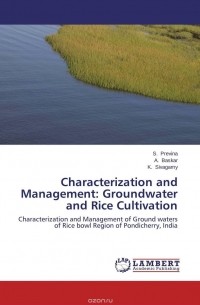K. Sivagamy — новинки
-
Characterization and Management: Groundwater and Rice Cultivation K. Sivagamy, S. Previna, A. Baskar
ISBN: 9783659478109 Год издания: 2013 Издательство: LAP LAMBERT Academic Publishing Язык: Английский The introduction of Green Revolution Agriculture(GRA)had paved the way for attaining self sufficiency in India, with respect to its food production. Major important component of GRA for increasing production is irrigation. Due to GRA, the ground water resources are exploited all over the country almost to its maximum potential.The combination of two major sectors (Agriculrure and Industries) in utilizing the ground waters of Pondicherry region had resulted in the salinization of water causing huge problems both for agriculture and industries. Further investigations had shown that the crops were affected by hydrogen sulphide injury, which has resulted due to irrigating with sulphate rich water and submergence for a longer period of time. The source of sulphate in the ground waters was identified to be the sea water which has intruded into the ground water due to over exploitation of ground water aquifers. Keeping all the these points in mind, Agro - Ecologically sustainable management practices are demonstrated in this text book to mitigate the poor quality of ground water as well as to reclaim the sulphate rich soils in the rice bowl region of coastal Agro Ecosystems. -
Scientific Utilization of Treated Distillery Effluent on Sugarcane K. Sivagamy, S. Previna, A. Saravanan
ISBN: 9783639700558 Год издания: 2013 Издательство: Scholars' Press Язык: Английский Sugarcane producing countries running sugar industries and apart from the sugar and alcohol, these factories generate many by-products and waste materials like solid waste (press mud), molasses and bagasse. The effluent in distillery industry plays a prime role in bridging the gap between the depletion and repletion by its inherent potential of high organic carbon and nutrient contents. Although the distillery effluent utilization in agriculture has augmented the crop yields, its unscientific and unsystematic use causes degradation of land and the environment. To harmless its full manurial potential, there is a recommendation of one time land application and distillery effluent through irrigation water as a source of plant nutrients for sugarcane crop and also to sustain the soil health. Thus, wherever there is uncontrolled discharge of distillery effluent, the environment is aesthetically unpleasant. Scientific utilization of distillery effluent in agriculture would save costs on fertilizers and facilitate reduction in pollution load on the environment and also improve the overall soil health. -
Agronomic practices for sustainable sesame yield in coastal region C. Babou, K. Sivagamy, S. Previna
ISBN: 9783659477560 Год издания: 2013 Издательство: LAP LAMBERT Academic Publishing Язык: Английский Sesame (Sesamum indicum L.) is the oldest oilseed crop known and cultivated by man. Among the oilseed crops, sesame ranks first for having the highest oil content of 46-64 per cent and 6355 K cal per kg dietary energy in seeds. The seed of sesame is also rich in protein (20-28 %), sugar (14-16 %) and minerals (5-7 %).The specific reasons identified for the low yield of sesame in India is due to its cultivation under sub-marginal lands without due importance to the choice of appropriate season, high yielding variety, nutrient management and new agro-technological packages. One way of increasing the productivity in sesame is by increasing the number of branches leading to increase in total number of capsules per plant. Maintaining the plant population also plays a vital role in realizing the yield potential of sesame. Possibility of cultivation of sesame in summer season under irrigated condition wherever supplemental water resource is available had not been tried or practiced by the farmers of this region. Therefore, selection of suitable variety, time of sowing, appropriate geometry and agronomic technologies are importance for increasing the productivity of sesame in this region. -
Weed management in transgenic and non transgenic maize hybrids K. Sivagamy, S. Previna, C. Chinnusamy
ISBN: 9783639700909 Год издания: 2013 Издательство: Scholars' Press Язык: Английский Maize is the third most important crop in the world agricultural economy after wheat and rice with an area of 168.26 million hectares with a production of 854.59 million tonnes with average productivity of 5120 kg / ha. Weed management in maize is carried out by manual, mechanical and chemical methods, among which chemical method is the most economical and effective tool to suppress weeds in order to get healthy crop stand and good yield. Advancement in biotechnological research enables genetic engineering to enhance production and minimize crop yield losses through development of crops that are tolerant to insects and herbicides. Genetically modified crops are the most rapidly adopted technology in agricultural history due to the social and economic benefits. Major yield reducing factors for maize cultivation are weeds and insects. Transgenic corn hybrids with stacked event (TC1507 X NK603) were developed for preventing yield losses of corn and improve the productivity. The stacked product having both insect protection and herbicide tolerant traits will provide protection to the crop against target pests and also provide effective weed management system to farmers.




